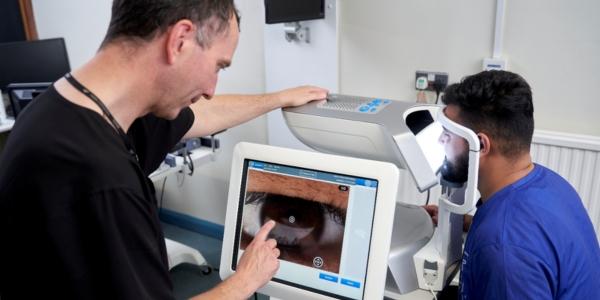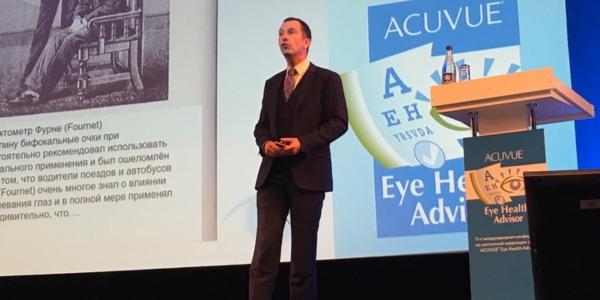3:0min

This story was created and shared by Optometry Victoria South Australia (OV/SA).
Professor James Wolffsohn has seen optometry from many different angles, from his lectures around the world on dry eye to researching how to improve heads-up displays for fighter pilots in the UK.
“I’m very optimistic about the future. It’s one of the most exciting times for our profession since its inception.”
After humble beginnings searching for a career in science, James Wolffsohn now regularly co-ordinates optometry global research publications, starting with a consensus report around dry eye in 2017 that had an impact around the world and following on with a report in myopia control in 2019 and a report on contact lenses in 2021. But even with his extensive knowledge of optometry journals, James says he finds it “impossible to keep up with the literature”.
Optometry Victoria South Australia sat down with James to hear about his thoughts on how optometry can adapt to a changing world and his upcoming keynote address, “The Power of Consensus”, which he’ll deliver at O=MEGA23/WCO4 in September.
OV/SA: What is your “optometry story”? How did you get here?
JW: I fell into optometry, really. I studied maths, physics, and chemistry for my A-levels, and I always wanted to be something that involved multiple sciences, but at that time it wasn’t a promising time to go into teaching or engineering. So I went to see the father of one of my friends, who was an optometrist, and I went along for the undergraduate ride until one day I had a degree. After that I ended up doing a PhD in the field, and now I lecture around the world, principally on myopia, dry eye, and contact lenses.
My PhD was an interesting application of optometry principles – it was all about virtual reality and heads-up displays on military aircraft. Their jets had heads-up displays, focused on far distance, and they had a slight problem with the pilots unable to properly detect nearby terrain. In short, their jets were accidentally flying into mountains. So my PhD was looking at how a pilot’s focus changes and drifts, and calibrating the heads-up displays at the sweet spot where it’s most accessible. The goal was to provide the pilot with information without requiring them to look down at a screen, and we developed practical approaches to overcome these problems.
After that, I came to Australia to do a post-doc, including working with Anthea Cochrane in low vision, who is now an academic liaison with Optometry Victoria South Australia, and then I returned to the UK at the turn of the millennium. I’ve travelled all around Australia on lecture tours, and I come back fairly regularly for research and on speaking engagements like the upcoming O=MEGA23/WCO4 conference in September.
OV/SA: Speaking of O=MEGA23/WCO4, what will you be speaking about in September in your keynote address?
JW: My address is titled “The Power of Consensus”, and it’s all about feeling secure in how you practice, how you can give your patients a better service, and how you can embrace change in a safe and secure way.
Eyes are what I would describe as ‘the windows to the body’. By looking at people’s eyes, you can pick up hypertension, cholesterol, diabetes, and more. For example, my main area of study is dry eye, and a lot of the research done in the area is closely related to dermatology. People who treated varicose veins or rosacea found their dry eye improved as well, so there are clearly aspects of dermatology we can borrow and adapt. This is already happening with some other sciences, like when optometrists talk to patients, particularly if they have a serious or lifelong disease, they borrow ideas from psychology to make the patient experience better. We’re not working in an isolated situation. There’s plenty of techniques to learn and adopt from neighbouring fields, and all of it feeds back into a better quality of care for patients.
This doesn’t have to be purely theoretical either. If you’re at the dentist, for instance, and they need to look something up, I’d prefer they do so than try to apply something they learned 30 years ago at university on my teeth. They have instruments today that can collect data and detect things they wouldn’t have even thought to look for when that dentist was being educated, and optometry is no different.
So what does this mean in practical terms?
It’s such a critical time for optometry. Opportunities are increasing rapidly, but it’s about optometrists being engaged. More and more journals are publishing papers each year, so there’s lots of new research being done, but now you have to be critical with what you read rather than just assuming every paper is good science. However, it’s almost impossible to keep up with the literature nowadays, so that’s where it’s crucial for experts to provide good science based on consensus. The reports I have helped steer act as an available library of dry eye knowledge, for instance, so I would hope optometrists could use it as a point of reference whenever they need to.
Essentially, by experts critically appraising the available literature and reaching consensus, it creates a reference for others to look up what they need to know, rather than rely on knowledge from their university days which becomes outdated at an increasing rate due to technology.
OV/SA: What does this mean for optometrists and patients heading into the future?
JW: I think there are challenges and opportunities. There’s the potential for the profession to split, between those who want to offer advanced services and those who want to offer conventional services. There is demand for both, so it is about people finding their niche, and people don’t need to be scared either way. There aren’t enough optometrists in the world and demand on eye care is increasing, so a lot of professional friction has melted away now that there’s work to go around. That said, I also know colleagues who are struggling to keep practices afloat, so there are real challenges too.

I think a lot of people find change scary, but it actually does make your life more interesting. People who engage with research and take up something new like myopia control improve their practice and their enjoyment, and also benefit their patients, an important thing to note given none of us would have gone into the profession without that kind heart and that goal to offer hope. We’re not going to cure things overnight, but we can help them more every day.
Optometry is a relatively small profession with big opportunities, so optometrists will always find a role. We need to work with other professions, and as eye-care is getting stretched, optometry has more space than ever to be of use. We need to be proactive like dentistry; imagine if we could get the standard of eye care up to the profile that something like brushing your teeth has in the mind of the public? There are lots of things we can be proactive about when patients are young to reduce the public health burden.
Now it’s about taking opportunities and running with them, and grabbing that entrepreneurial spirit. I’m very optimistic about the future. It’s one of the most exciting times for our profession since its inception.
James will be the keynote speaker at this year’s O=MEGA23/WCO4 conference in September. O=MEGA/WCO is brought to you by Optometry Victoria South Australia, Optical Distributors and Manufacturers Association, and the World Council of Optometry.
Tagged as: james wolffsohn, keynote, OMEGA23, WCO4